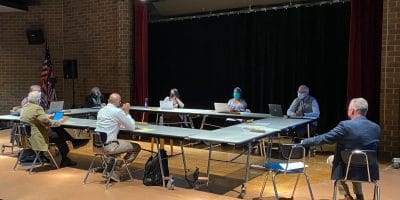By Calvin Pynn, contributor
Anticipating that the first COVID-19 vaccines will be administered locally in the next several weeks, the Virginia Department of Health is working with hospitals and healthcare associations to plan the initial distribution.
According to Dr. Laura Kornegay, director of the VDH’s Central Shenandoah Health District, several criteria still must be met before people begin receiving vaccines. One is a final Emergency Use Authorization from the Food and Drug Administration for two vaccines produced by the pharmaceutical companies Pfizer and Moderna.
“Those vaccines will probably be available and in place for when we get that green light for the prioritization of initial recipients,” Kornegay said.
VDH is also awaiting guidance from the CDC’s Advisory Committee on Immunization Practices, or ACIP.

“That’s really the body that guides our vaccine practices throughout, whether it’s flu vaccine, measles, mumps, and rubella vaccine, or the novel COVID vaccine,” Kornegay said.
The ACIP met Tuesday, and formally recommended that the country’s 21 million frontline healthcare workers and 3 million elderly residents and their caregivers in long-term care facilities be first in line for the vaccine.
“In general, it’s kind of kind of protecting our healthcare infrastructure so that we have people to care for folks who are continuing to be diagnosed with COVID and then kind of rapidly advancing through risk priorities,” Kornegay said.
The VDH’s Vaccine Advisory Work Group met Monday ahead of the ACIP’s meeting, where they estimated that only 70,000 vials of the vaccine would be available to Virginia, barely covering 10 percent of state residents who would qualify for early vaccination.
According to Kornegay, determining exactly who among Virginia’s 640,000 frontline healthcare workers and long-term care facility residents will get the very first vaccines will be determined by the ACIP’s forthcoming guidance document. She described the plan as a “rolling distribution.”
“When we [have that document], we can determine distribution, and then there’ll be incremental distributions as additional doses are produced,” Kornegay said.
VDH plans rollout in phases
Authorities plan to distribute the vaccine in three phases. First will come front-line healthcare workers and long-term care residents, then other essential workers and medically vulnerable people, with the general population vaccinated in a third phase.
Currently, it’s unclear whether the initial vaccines distributed in the Central Shenandoah Health District will be from Pfizer or Moderna. That will be determined by supply of the vaccines, Kornegay said.
“They both have very good efficacies, above 90%. So, you’re not trying to determine one that may have a real high efficacy versus one that’s much lower.” Kornegay said.
According to Kornegay, the COVID vaccine will require two doses injected into the upper arm several weeks apart. Like other multi-dose vaccines, both doses must come from the same manufacturer. The VDH plans to track this with a cloud-based Vaccine Management Administration System, or VMAS.
Storage of the vaccine, which must be kept at ultra-cold temperatures, will occur at healthcare facilities with equipment capable of keeping vials at -20 to -30 degrees Celsius, as well as any other places with similar storage capabilities, such as university science departments.
“We’re looking at the distribution of this vaccine sort of like spokes on a wheel. You need to find some ultra-cold place to store the vaccine. But that doesn’t necessarily mean that that vaccine is going to be dedicated to that place with the ultra-cold storage,” Kornegay said. “So, we’ll find strategically placed storage facilities and then from there, be able to allocate the vaccine itself.”
Other institutions also preparing for vaccine distribution

In an email to The Citizen, James Madison University spokesperson Mary-Hope Vass said that plans for storing and administering the vaccine on campus have yet to be finalized.
“While it is too early to discuss specific plans, JMU is committed to being a partner to the community and to VDH as the time to administer the vaccine comes closer,” Vass wrote.
Sentara RMH spokesperson Neil Mowbray relayed plans from the hospital’s corporate office to distribute the vaccine. In an email, he said the vaccine will not be mandatory for hospital staff.
Those working in RMH’s highest-risk areas for COVID – including the emergency department, ICU, and COVID unit – will be the first to receive the vaccine. After that, doses will expand to the rest of the staff according to supply.
“It will be based on the number of vaccines available and staff who indicated they wish to receive the vaccine (it will be optional). We will expand to other areas as we receive additional shipments,” Mowbray wrote.
He said the number of vaccines initially available to RMH has yet to be determined, as it’s still unknown how many will be available to all of Sentara’s hospitals. The network was designated as an early adopter of the vaccine in Virginia, and initial doses of the vaccine will be allocated to Sentara Norfolk General Hospital before being redistributed to employee health clinics affiliated with Sentara’s 12 hospitals. There, RNs will administer the vaccine, just as they do with other immunizations year round.
According to Kornegay, distribution of the vaccine will be a massive undertaking requiring collaboration between both public health entities and the private sector.
“We have about 300,000 or so citizens within our district, that’ll be kind of our general responsibility, but there are lots, lots more people in the state and the country. That’s gonna really require coordination from lots of different community partners at the federal level.”
Both Walgreens and CVS pharmacies have contracted with the federal government to administer vaccines at long-term care facilities.
“Those two entities would be able to provide the vaccine onsite to those folks in congregate living situations. That’s going to be a great force multiplier for public health, having that population taken care of,” Kornegay said.
Staff at Virginia Mennonite Retirement Community in Harrisonburg are still coordinating plans for the vaccine.
“Leaders who are part of VMRC’s COVID response team are staying abreast of news concerning the COVID vaccine. We will communicate our plans to residents, family members and employees in the very near future. We aren’t able to provide details since we are still discussing and formalizing those plans,” VMRC Vice President for Marketing and Communicatiosn Maureen Pearson said in an email to The Citizen.
An end in sight
While she has heard some concern about the extremely rapid development of the vaccine, Kornegay said that no corners were cut in the process.
“One of the things, I think, that helped at the beginning of the pandemic is the point in medical history that we’re at now – particularly in terms of genetic research. We were able to quickly identify the virus, and see a genetic sequence in order to develop a test to look for it. That’s something a decade or two ago we really wouldn’t have had the skill sets to do that quickly,” she said.
Even as the vaccines’ arrival draws near, COVID cases and deaths are hitting their highest numbers of the entire pandemic. Kornegay warned that it’s not time to ease up on mitigation.
“We’re nine months into the pandemic and I’d have to say that, uniformly, a lot of people are getting pandemic-weary. They’re tired of restrictions, tired of mask wearing, tired of social distancing, and unfortunately, we’re not at the end of the pandemic,” Kornegay said.
Still, she said, we’re in the home stretch.
“Any vaccine takes a week or two to be effective, and you’re going to have these waves of people getting effective immunity, and it’s gonna trail on for some months into the interim. We’re still gonna have folks who are susceptible to the disease, and hopefully less transmission within our communities. But the good news is that we have an end in sight,” Kornegay said.
Journalism is changing, and that’s why The Citizen is here. We’re independent. We’re local. We pay our contributors, and the money you give goes directly to the reporting. No overhead. No printing costs. Just facts, stories and context. We’re also a proud member of the Virginia Press Association. Thanks for your support.














